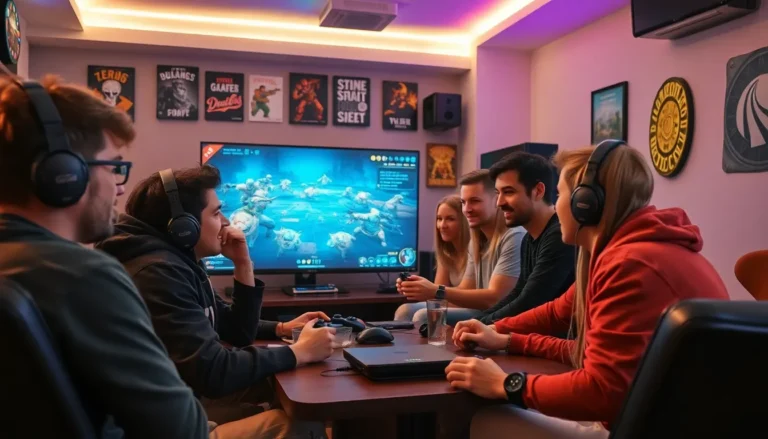Table of Contents
ToggleIn today’s tech-obsessed world, finding a balance in a digital routine feels like trying to juggle flaming swords while riding a unicycle. With notifications buzzing and screens glowing, it’s easy to get swept away in the digital tide. But fear not! Striking that perfect balance isn’t just a fantasy; it’s a skill anyone can master.
Understanding Balance Digital Routine
Achieving a balanced digital routine is essential in today’s technology-saturated environment. Developing this skill can significantly improve overall well-being.
Importance of Digital Balance
Maintaining digital balance enhances mental health and productivity. An effective routine minimizes distractions and allows individuals to focus on tasks. Setting boundaries around device usage fosters deeper connections with family and friends. Structured screen time can also promote better sleep patterns, aiding physical health. Research indicates that individuals who prioritize digital balance experience reduced anxiety and stress. Implementing strategies for better digital habits creates a more enjoyable online experience.
Effects of Digital Overuse
Digital overuse leads to a variety of negative consequences. Prolonged screen time can cause eye strain, headaches, and fatigue, impacting daily performance. Mental well-being suffers due to constant notifications, which often create a sense of urgency. Reduced face-to-face interactions can diminish social skills and feelings of isolation. Additionally, excessive use of social media contributes to unrealistic comparisons and lowers self-esteem, particularly among younger users. Understanding these effects underscores the need for a balanced approach to technology.
Strategies for Achieving Balance


Achieving a balanced digital routine involves actionable strategies that promote healthy tech usage. These methods help minimize the negative effects of excessive screen time.
Establishing Screen Time Limits
Setting screen time limits aids in curbing digital overload. Begin by determining daily usage goals, such as restricting recreational screen time to two hours. Prioritize essential tasks during work hours to reduce distractions. Utilize apps that track screen time and send reminders when limits are near. Additionally, designate specific times for technology use, making it easier to stick to those boundaries. Engaging in other activities, such as exercise or reading, fills time previously spent on screens and enriches overall well-being.
Incorporating Tech-Free Zones
Creating tech-free zones fosters healthier interactions. Designate areas, such as bedrooms or dining tables, where devices are not allowed. Ensure family time remains uninterrupted by digital devices, encouraging meaningful connections. Establishing these zones prevents distractions during bedtime, promoting better sleep quality. Families can organize tech-free activities like board games or outdoor outings. By consciously setting aside space free from screens, individuals enhance their focus on real-world engagements and relationships.
Tools and Apps for Digital Balance
Utilizing the right tools can enhance digital balance. Several applications and resources assist in monitoring screen time and promoting mindfulness.
Recommended Apps for Monitoring Usage
Various apps track screen time and help manage device usage. Screen Time provides detailed reports and encourages limiting distractions. Moment tracks daily phone usage and sends alerts to raise awareness of excessive screen habits. Another option, Forest, gamifies focus by growing virtual trees based on focused time, fostering productivity while limiting phone distractions. StayFree offers insights into app usage and trends, helping users understand their behavior patterns. These apps motivate individuals to adopt healthier digital habits.
Tools for Mindfulness and Focus
Mindfulness tools enhance concentration and promote a balanced routine. Headspace offers guided meditations focusing on reducing stress and enhancing attention. Calm combines relaxing music and soundscapes while facilitating sleep improvement and mindfulness. Focus@Will delivers curated music tracks designed for improved concentration during work or study sessions. Using RescueTime allows users to analyze productivity trends, pinpointing areas for improvement. Implementing these tools cultivates a mindful approach toward technology, fostering better interactions and well-being.
Benefits of a Balanced Digital Routine
A balanced digital routine offers significant advantages. Individuals experience enhanced productivity, improved mental health, and better interpersonal relationships.
Enhanced Productivity
Structured screen time leads to better focus throughout the day. Setting specific limits on device usage allows for prioritized tasks to take center stage. Increasing productivity occurs when distractions decrease, enabling individuals to complete tasks efficiently. Tools for managing screen time, such as productivity apps, help track usage and reinforce accountability. This heightened awareness improves time management and promotes intentional engagement with technology. Overall, a balanced digital routine creates a conducive environment for accomplishing goals.
Improved Mental Health
Maintaining a balanced digital routine promotes improved mental health. Reducing screen time correlates with decreased anxiety and stress levels. Individuals often find that tech-free zones contribute to mindful interactions, fostering genuine connections with family and friends. Decreased reliance on digital devices helps mitigate the negative impacts of social media, leading to healthier self-esteem. Mindfulness apps can also support mental well-being by encouraging relaxation and focus. This holistic approach cultivates a more positive and stable mental state.
Finding balance in a digital routine is crucial for maintaining mental health and productivity. By implementing practical strategies and utilizing helpful tools, individuals can create a healthier relationship with technology. Setting screen time limits and designating tech-free zones fosters deeper connections and enhances overall well-being.
As people become more mindful of their digital habits, they can experience reduced stress and anxiety while improving focus and efficiency. Embracing this balanced approach not only enhances personal interactions but also promotes a more positive and fulfilling lifestyle. Prioritizing a thoughtful digital routine empowers individuals to thrive in today’s technology-driven world.







